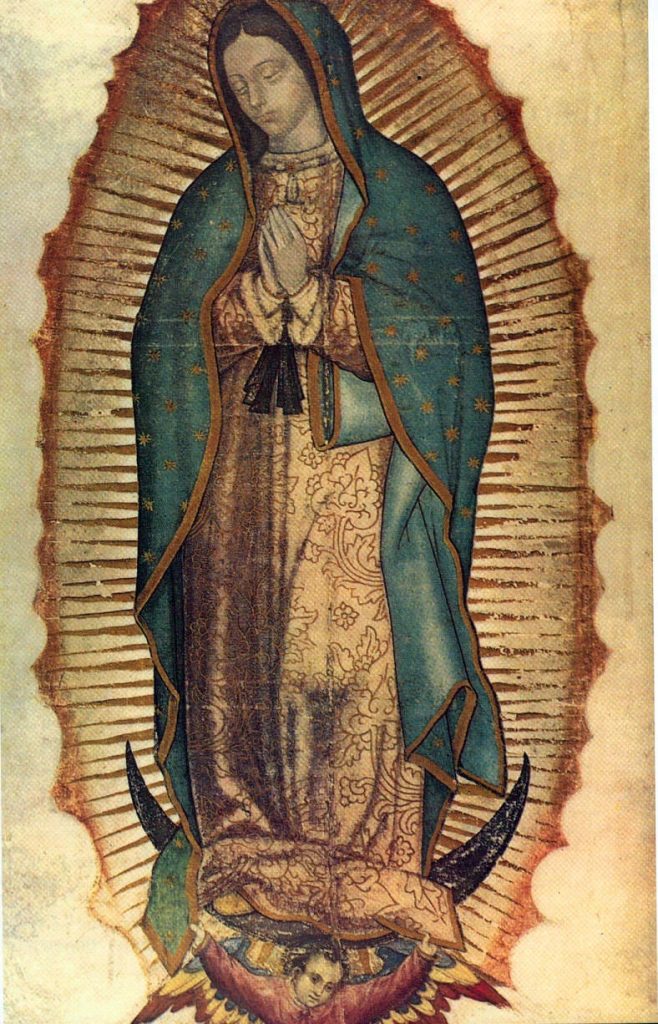Lessons from Our Lady of Guadalupe

It was one of those times when the whole world was spinning upside-down. For 200 years the Aztec empire reigned over much of what is now Mexico. Then, in the early 1500s, Spanish explorer-soldiers appeared in Aztec land. They made their way to the capital city, Tenochtitlán, and over the course of three years of struggle, they overtook the city and toppled all its buildings – even the great temple complex of 80 towering buildings that had once been the center of the city’s ritual life. Over the ruins they began to construct new buildings of the European style. They renamed Tenochtitlán “Mexico,” because it was easier to pronounce.
In just a few years, the indigenous people not only encountered an entirely new culture – they were overtaken by it, the way of life they knew was pulled out from under them, their whole world was suddenly and violently changed.
In this world, ten years after the destruction of the city, a poor indigenous man named Juan Diego left his house and walked towards the church for mass. As the story is told: music drifted down to his ears, and he followed the enchanting sound up a hill, where he had a vision of Mary, the mother of Jesus. She appeared with symbols of deep significance for both the indigenous and Roman Catholic traditions.
She said to him: “I wish a shrine to be built here to show my love to you. I am your merciful mother, thine, and all the dwellers of this earth.” She sent him to the bishop to give him her message.
The bishop, of course, did not believe the words of a poor indigenous man – especially when he was claiming miracles. So Juan Diego returned to the place where he met Mary, and he confessed his failure to her. Then he said, “Send, Lady, a person of mark that [the bishop] may believe it. My lady, I am a paltry fellow, a man of straw, a bumpkin, a commoner.”
It’s the familiar response of those called by God to a special task: “But I’m not good enough!” or “Lord, this isn’t working!”
But Mary replied to Juan Diego: “Listen, my son, least of my sons. Many are my servants whom I can charge with my message; yet I wish it to be thou to make my petition, to help by thy mediation my will to be accomplished.” It wasn’t just a shrine Mary wanted; she wanted this poor indigenous man to be the one who caused it to be built. It had to be him. That was part of the miracle, part of the divine plan.
Yet still the bishop rejected Juan Diego. This time, Mary gave him a sign he could take back to the bishop. From the top of her hill, Juan Diego picked an armful of miraculous flowers – flowers that could not have been blooming in the winter. This time when Juan Diego went to the bishop, he let go of the hem of his cape, the flowers tumbled to the floor – and on his plain, poor cape shone an image of Mother Mary, just as she had appeared to him on the hillside. The bishop finally believed Juan Diego; Mary’s shrine was built; and today Juan Diego’s cape still hangs above the altar, the image of Mother Mary reminding all visitors of divine love for the whole world.
This image has come to be known as Our Lady of Guadalupe. She has been a central symbol of Mexican identity for 500 years; an icon that has rallied independence movements, a story that has comforted and inspired millions of people. Her shrine – the Basilica of Our Lady of Guadalupe in Mexico City – is the most-visited Catholic shrine in the world, and the third-most visited sacred site among all the world’s religions. This past Monday – the feast day of Our Lady of Guadalupe – the streets of Mexico City filled with celebration. In Des Plaines, IL, hundreds of thousands of people gathered at the Shrine of Our Lady of Guadalupe for the largest U.S. celebration in her honor.
Perhaps the story of Juan Diego and Our Lady of Guadalupe has captured so many hearts because it carries the heart of the Gospel: that God loves us and chooses us even when the world – and our own selves! – reject us as not good enough. That God, in fact, chooses over and over again to work salvation through the most surprising of people and circumstances: Moses, with his fear of public speaking; Mary, an unwed pregnant teenage peasant girl; the public execution of a Galilean holy man. This is how God sets the world spinning-upside down….or is it right-side-up?
“God chose what is weak in the world to shame the strong; God chose what is low and despised in the world, things that are not, to reduce to nothing things that are, so that no one might boast in the presence of God.” (1 Cor. 1:27-29).
+++
Pr. Kate
Dec. 14, 2022
Pastor Kate and Pastor Jim take turns writing weekly devotions for the Chapel of the Resurrection. Contact them here: